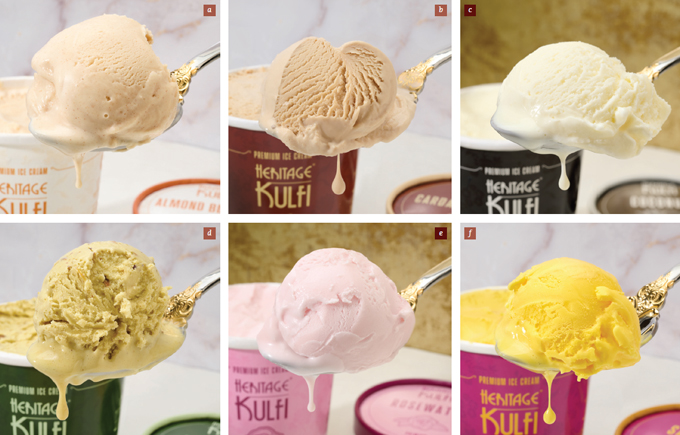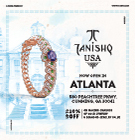Food & Dining: Cool Kulfi

Made by simmering whole milk on low heat for hours, stirring continuously until the milk thickens and caramelizes, this Indian version of ice cream is creamier and denser, and is gaining ground in America.
On summer afternoons in Atlanta, I often yearn for my childhood memories of heading to Krishna Di Kulfi at Pandara Road Market in New Delhi. Every so often, after dinner, and usually with friends and family, we would venture out to this famous joint for its deliciously decadent kesar-pista kulfi sticks. The kulfiwalla would reach into a giant matka (clay pot), pull out the steel cones, dip them in hot water, and then skillfully extract the frozen goodness onto a small plate. While eagerly anticipating my first bite, I would watch him slice the creamy kulfi stick and garnish it with velvety falooda, sweet rose syrup, and chopped pistachios.
Even as an adult, I look forward to visiting the kulfi shops in India each time I return. I wish there were similar corner stands around Atlanta where I could satisfy my homesickness for kulfi. Sure, it is on the menu at a few Indian restaurants, most of whom source it from Shahi Kulfi, a commercial brand based in Sterling, Virginia. This brand and others like Vadilal are also sold in the frozen section of most Indian grocery stores. They come in individually-wrapped kulfi sticks and tubs. Both are decent, but there's something missing—perhaps the face of the chef who made it.

 What's so different about kulfi?
What's so different about kulfi?
Kulfi, a South Asian frozen dessert that predates ice cream, originated in 16th-century Delhi during the Mughal era and spread across neighboring countries. While dairy-based desserts became increasingly abundant in Indian cuisine, kulfi made at home and then sold by hole-in-the-wall vendors called kulfiwallas, became a staple.
[Right] The entire Singh family is involved in growing the Kaurina’s brand, which is now available at 14 Whole Foods locations throughout Dallas-Fort Worth, 120 Costco locations nationwide, and some Indian stores like Patel Brothers and India Bazaar.
Kaurina’s Kulfi grew from Singh's kitchen table to a 30,000-square-foot factory in Farmers Branch, Texas.
The main distinction between ice cream and kulfi is the cooking process, which is simple but requires patience. Like rabdi, kulfi is made by simmering whole milk on low heat for hours, stirring continuously until the milk thickens and caramelizes. It is then poured into molds called “kulhars,” sealed, and submerged in an insulated clay pot filled with ice and salt. This traditional preparation is called “matka kulfi.” It is denser than ice cream because there's no added air. This also means it melts slower than ice cream, allowing one to savor it for almost 30 minutes.
Kulfi in America
When I first moved to the U.S., I tried making my grandmother's recipe a few times. Eventually, though, laboring over a pot of hot milk for hours was overruled by a busy schedule and the convenience of store-bought ice cream.
Thankfully, other Indian families ventured further with their passion for kulfi. When Jas and Hari Singh immigrated to the U.S. from Chandigarh, India, in 1977, this Indian delight was nowhere to be seen in American stores. Jas started making small batches for her friends and family using the authentic method handed down to her by her mother and grandmother. As word spread about it in her hometown of Dallas, Texas, she was encouraged to start her own kulfi business, giving rise to Kaurina's Kulfi in 2000. The entire family joined the business, which grew from Singh's kitchen table to a 30,000-square-foot factory in Farmers Branch, Texas. Today, Kaurina's Kulfi sells bars and pints of their frozen treats at 14 Whole Foods locations throughout Dallas-Fort Worth, 120 Costco locations nationwide, and some Indian stores like Patel Brothers and India Bazaar.
 Jas Singh's son and Kaurina's CEO, Aman Singh, explains that making artisanal kulfi is a two-day process that cannot be rushed. But the result is a healthier and more satisfying version of ice cream. Unlike the heavy cream used in ice cream, their kulfi is made with half-and-half, which has a similar fat content to buffalo milk. It has no added emulsifiers, preservatives, gums, stabilizers, or artificial sweeteners.
Jas Singh's son and Kaurina's CEO, Aman Singh, explains that making artisanal kulfi is a two-day process that cannot be rushed. But the result is a healthier and more satisfying version of ice cream. Unlike the heavy cream used in ice cream, their kulfi is made with half-and-half, which has a similar fat content to buffalo milk. It has no added emulsifiers, preservatives, gums, stabilizers, or artificial sweeteners.
[Left] Mansoor Ahmed wanted to create a niche that would go beyond the traditional malai and pista flavors.
Kaurina's Kulfi is packed into pints and kulfi pops, making it easier for consumers who are unfamiliar with the product to recognize it as ice cream. Pumping air into the kulfi also makes it less solid and easily scoopable. However, Aman still recommends turning the pint upside down and cutting it into pieces, which he demonstrates in a video titled "How to Serve Kulfi."
Mansoor Ahmed, who ran a frozen food distribution company in Princeton, New Jersey, found a gap in the industry when it came to ice creams that featured Indian ingredients. During COVID, he decided to capitalize on America's fast-growing desi food market by creating a premium kulfi brand. He learned everything about commercial ice cream making, did his own research and product development, and launched Heritage Kulfi in 2022. He wanted to create a niche that would go beyond the traditional malai and pista flavors, offering robust ones like Cardamom Chai, Alphonso Mango, Earl Grey, Saffron, Rosewater, Almond Blossom, and Coconut among others, incorporating Indian spices, nuts, fruits, and teas.
"We don't want to ignore the nostalgic and rich history of kulfi but elevate it with the churning process of ice cream and use only real ingredients," says Ahmed. He is often found in the factory steeping hundreds of pounds of tea leaves and cardamom pods, while experimenting with new flavors. Heritage Kulfi is available at several stores, mainly in the Northeast and West Coast, but can be shipped directly to your doorstep in dry ice.

Some of the flavors of Heritage Kulfi: a. Almond Blossom; b. Cardamom Chai; c. Coconut; d. Pistachio: e. Rosewater; f. Saffron
Mainstream Ice Cream?
Ahmed and Singh are working to make kulfi the next big mainstream ice cream category in the U.S. Thanks to their product demonstrations at Whole Foods and availability at warehouse retailers like Costco, artisanal kulfi brands are gaining more awareness and appreciation.
As I look around, I see a few other kulfi catering wholesale, and retail companies emerging nationwide. Crown Kulfi sells to 500 stores across the U.S. and Canada, Portland-based Kulfi PDX has two brick-and-mortar kulfi parlors, and The Kulfi Company caters to Southern California. It may not be long before we can satisfy our craving for this summer favorite by walking into a kulfi store nearby. In the meantime, there is always FedEx's next-day shipping to deliver a fresh batch to your door.
Sucheta Rawal is an award-winning food and travel writer who has traveled to over 100 countries across seven continents, experiencing the world through her palate. She has been named one of the most influential cultural bloggers in the world for her blog Go Eat Give. Find her on social @SuchetaRawal.
Enjoyed reading Khabar magazine? Subscribe to Khabar and get a full digital copy of this Indian-American community magazine.
blog comments powered by Disqus











